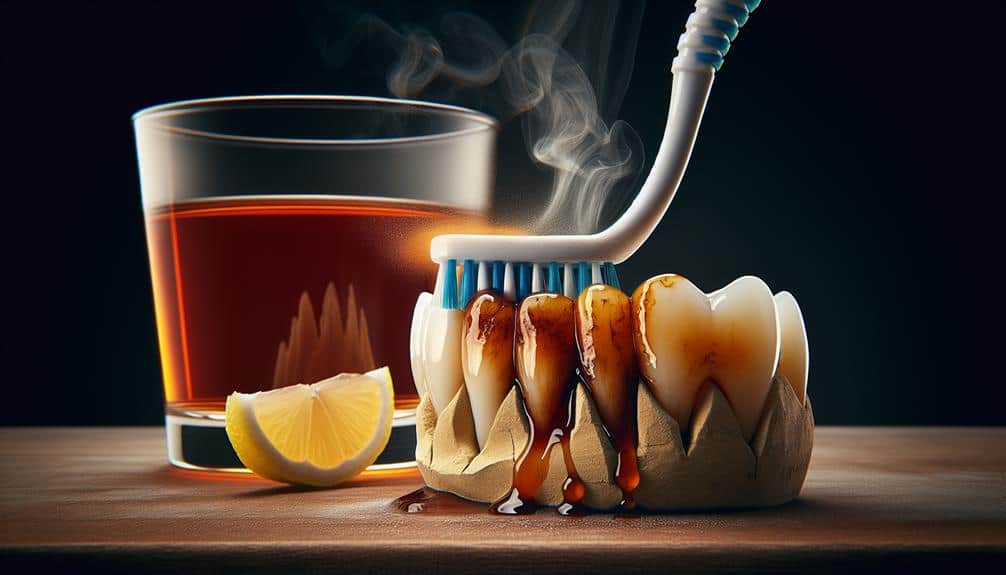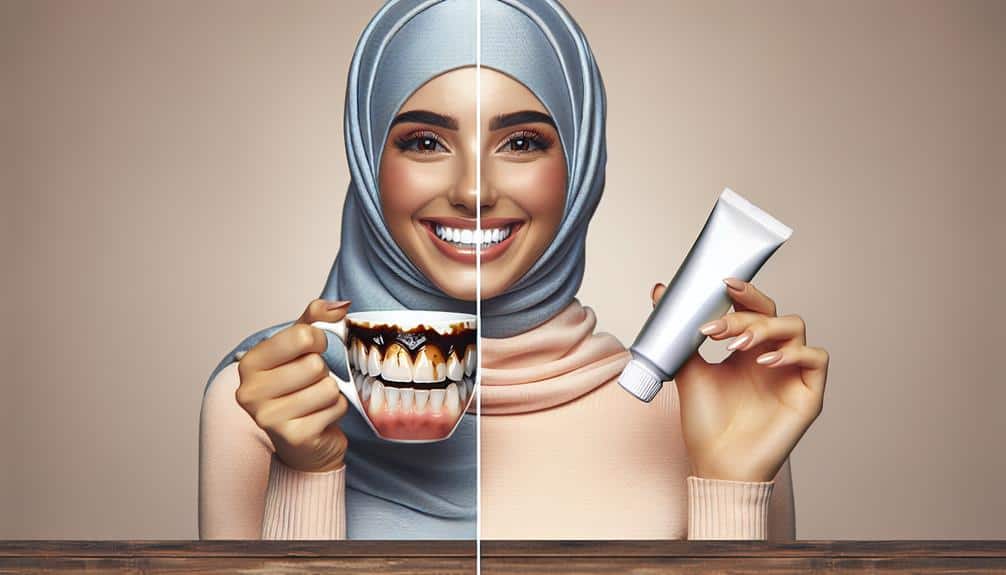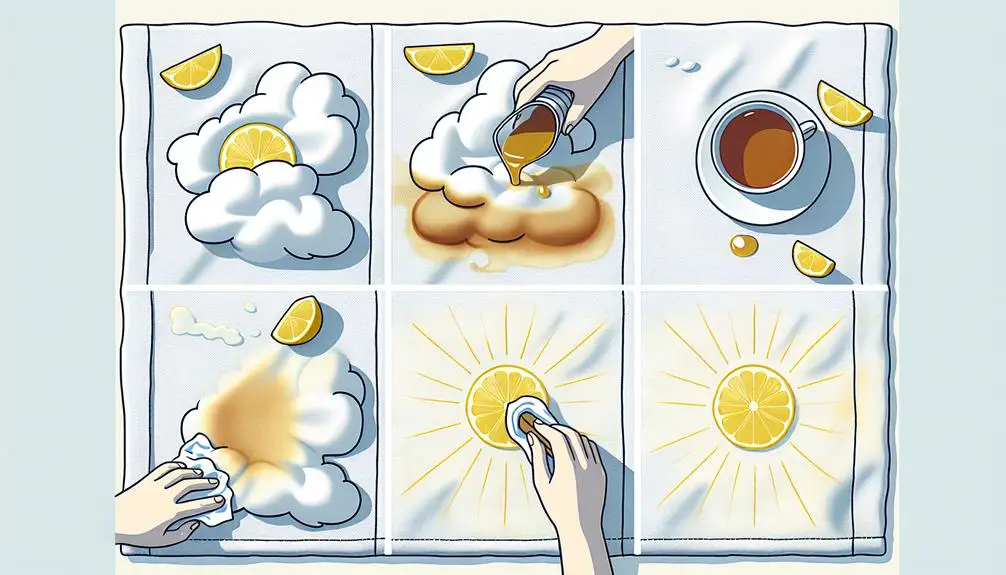To remove tea stains from teeth: Brush with baking soda. Rinse with apple cider vinegar. Use hydrogen peroxide. Try oil pulling. Apply activated charcoal. Utilize whitening toothpaste. Consider seeking professional whitening for stubborn stains. These methods can help restore your bright smile effectively.
Key Points
- Brush teeth with baking soda for natural stain removal.
- Rinse with apple cider vinegar to combat tea stains.
- Use hydrogen peroxide to whiten teeth effectively.
- Consider oil pulling as a holistic remedy for stain removal.
- Activated charcoal can help absorb and remove tea stains.
Brush With Baking Soda
For a gentle yet effective approach to removing tea stains from your teeth, consider brushing with baking soda. Baking soda is known for its natural teeth whitening properties and is often used in various home remedies. When using baking soda as a teeth whitening agent, it's essential to be mindful of baking soda alternatives and toothpaste options that contain this ingredient.
To brush your teeth with baking soda, simply dampen your toothbrush and dip it into some baking soda. Gently brush your teeth in a circular motion for about two minutes, ensuring that you cover all surfaces. Baking soda works by gently scrubbing away surface stains on your teeth, revealing a brighter smile over time.
While baking soda can be an effective option for removing tea stains, it's essential to use it sparingly to avoid damaging your tooth enamel. Additionally, consider consulting with your dentist for personalized recommendations on natural teeth whitening methods.
Rinse With Apple Cider Vinegar
Consider integrating apple cider vinegar rinses into your oral care routine for a natural approach to combating tea stains on your teeth. Apple cider vinegar is renowned for its numerous health benefits, including its potential to whiten teeth naturally. The acetic acid found in apple cider vinegar helps remove stains and kill bacteria in the mouth, promoting oral health in addition to aesthetics.
To incorporate apple cider vinegar as a teeth-whitening rinse, dilute it with water to reduce its acidity and prevent damage to tooth enamel. Mix one part apple cider vinegar with two parts water and swish the solution around in your mouth for about 30 seconds. Then, rinse your mouth with plain water to eliminate any residual vinegar.
While apple cider vinegar can be an effective natural remedy for teeth whitening, it's vital to use it cautiously to avoid any adverse effects on your oral health. Integrate this rinse into your oral care routine periodically for a gentle and natural way to combat tea stains and promote a brighter smile.
Use Hydrogen Peroxide
To effectively utilize hydrogen peroxide for removing tea stains from your teeth, it's important to take into account the safety aspects of this method. Understanding the proper application method for teeth and the recommended frequency of use are key factors to achieve desired results without causing harm.
Safety of Hydrogen Peroxide
When using hydrogen peroxide for teeth whitening, make sure appropriate precautions are taken to prioritize safety and minimize risks. Safety measures include using a low concentration of hydrogen peroxide, typically between 3% to 10%, to reduce the likelihood of irritation or damage to the teeth and gums.
It's vital to follow the recommended guidelines for usage and not exceed the suggested duration or frequency of application. Additionally, consider alternatives like whitening toothpaste or professional dental treatments for those with sensitive teeth or existing dental issues.
Always consult with a dentist before starting any teeth whitening regimen to guarantee it's safe for your specific oral health needs.
Application Method for Teeth
For effective whitening using hydrogen peroxide on your teeth, make sure a precise and controlled application method is employed. Begin by mixing a small amount of hydrogen peroxide with an equal part of water to create a gentle solution. Dip a clean toothbrush into the mixture and gently brush your teeth for about two minutes, ensuring all surfaces are covered.
Alternatively, you can swish the solution around in your mouth for about a minute, reaping mouthwash benefits like freshening breath. Be cautious not to swallow the solution. Remember that excessive use can lead to tooth sensitivity, so consider natural remedies for enamel protection, such as incorporating enamel-strengthening toothpaste into your dental routine.
Frequency of Use
Consider using hydrogen peroxide for teeth whitening no more than once a week to avoid potential tooth sensitivity. When addressing tea stains, the importance of hydrogen peroxide application frequency plays a significant role in maintaining dental health.
Here are some essential points to keep in mind:
- Tea Consumption: If you're a regular tea drinker, limiting the use of hydrogen peroxide can help prevent new stains from forming.
- Stain Prevention: Using hydrogen peroxide sparingly can aid in preventing stubborn tea stains on your teeth.
- Dental Sensitivity: Overuse of hydrogen peroxide can lead to increased tooth sensitivity, especially in individuals prone to dental issues.
- Consultation: If you have concerns about the frequency of hydrogen peroxide use, consult with a dental professional for personalized advice.
Try Oil Pulling
Ready to explore another effective method for removing tea stains from your teeth?
Oil pulling is a natural technique with numerous benefits for oral health, including whitening teeth.
To oil pull, simply swish a tablespoon of coconut or sesame oil in your mouth for about 15-20 minutes to help eliminate tea stains and promote a brighter smile.
Oil Pulling Benefits
To experience the benefits of oil pulling, swish a tablespoon of coconut oil in your mouth for 15-20 minutes each morning before brushing your teeth. Oil pulling is an ancient practice known for its potential to improve oral hygiene and overall health.
- Reduces Harmful Bacteria: Oil pulling can help reduce the number of harmful bacteria in your mouth, promoting better oral health.
- Whitens Teeth: Regular oil pulling may contribute to a brighter smile by removing surface stains on teeth.
- Fights Bad Breath: By eliminating bacteria, oil pulling can help combat bad breath and leave your mouth feeling fresher.
- Supports Gum Health: Oil pulling has been linked to reducing inflammation and promoting healthier gums.
How to Oil Pull
For effective oil pulling, begin by taking a tablespoon of coconut oil and swishing it in your mouth for 15-20 minutes each morning before you brush your teeth.
Coconut oil is a popular choice for oil pulling due to its antimicrobial properties, which can help improve oral health. When you swish the oil around in your mouth, make sure to push and pull it through your teeth and gums. This action helps to remove bacteria, plaque, and debris from your oral cavity.
The oil also helps to moisturize the gums and reduce inflammation. After 15-20 minutes, spit out the oil into a trash can to prevent clogging your sink. Remember, oil pulling is a natural and gentle way to support your oral hygiene routine.
Apply Activated Charcoal
Using activated charcoal can effectively help in removing tea stains from teeth. Activated charcoal is a porous substance that binds to toxins and stains on the teeth, making it a popular natural remedy for improving dental aesthetics.
Here are some tips for using activated charcoal to combat tea stains:
- Charcoal Toothpaste: Opt for a toothpaste that contains activated charcoal to help gently remove surface stains from tea and other beverages.
- DIY Charcoal Treatment: Create a paste by mixing activated charcoal powder with a small amount of water. Apply the paste to your teeth, leave it on for a few minutes, then rinse thoroughly.
- Use Sparingly: While activated charcoal can be effective, it's abrasive and can wear down enamel if used too frequently. Limit use to once or twice a week.
- Consult Your Dentist: If you have concerns about using activated charcoal or its effects on your teeth, seek advice from your dentist before proceeding.
Use Whitening Toothpaste
Think about incorporating whitening toothpaste into your oral care routine to help combat tea stains and enhance the brightness of your smile. Whitening toothpaste contains mild abrasives or polishing agents that can help remove surface stains caused by tea consumption. These toothpaste products work by gently scrubbing the teeth to lift off stains, revealing a brighter smile over time.
When selecting a whitening toothpaste, look for options that are specifically formulated for stain removal and teeth whitening. Ingredients like hydrogen peroxide or carbamide peroxide can be effective in breaking down and removing stains from the surface of your teeth. Using these toothpaste products consistently is crucial to see noticeable results in tea stain removal.
While whitening toothpaste can aid in maintaining a brighter smile and combating tea stains, it's crucial to remember that these products may not offer the same level of whitening as professional treatments. For more stubborn stains or faster results, you may want to think about seeking professional whitening options from your dentist.
Seek Professional Whitening
Explore professional whitening options for a more effective and efficient removal of stubborn tea stains from your teeth. When it comes to seeking professional treatment options for teeth whitening, the benefits are numerous. Professional whitening procedures are designed to target deep-set stains that may not respond well to over-the-counter products, offering a more thorough solution to tea-stained teeth. Here are some reasons why professional whitening may be the right choice for you:
- Tailored Treatment Plans: Professional dentists can customize the whitening treatment to your specific needs, ensuring excellent results.
- Stronger Whitening Agents: Professional whitening treatments use more potent whitening agents than over-the-counter products, leading to more effective stain removal.
- Long-Lasting Results: Unlike temporary solutions, professional whitening can provide enduring results, keeping your smile bright for an extended period.
- Supervised Procedure: Under the care of a dental professional, you can trust that the whitening procedure is conducted safely and effectively, minimizing risks and maximizing efficiency.
Consider professional whitening for a tailored approach to achieving a brighter, stain-free smile.
Frequently Asked Questions
Can Tea Stains on Teeth Be Prevented in the First Place?
To prevent tea stains on teeth, focus on dental hygiene. Brush and floss regularly to remove plaque that can hold onto stains. Visit your dentist for cleanings and check-ups to maintain oral health and address any potential causes of tea stains.
Are There Any Potential Side Effects or Risks Associated With Using These Methods to Remove Tea Stains From Teeth?
Considering potential risks when removing tea stains, be cautious about tooth sensitivity and enamel damage. It's important to balance effectiveness with oral health. Consult your dentist for personalized advice on maintaining a bright, healthy smile.
How Long Does It Typically Take to See Results When Using These Methods?
When using methods to remove tea stains from teeth, visible results in teeth whitening timelines vary. Typically, improvements start to show within a week. Consistent use of the methods can lead to a brighter smile over time.
Can These Methods Be Used for Removing Stains From Other Beverages Besides Tea?
When tackling stubborn coffee or wine stains, remember these methods can work beyond tea discoloration. Adapting techniques for different stains is crucial, ensuring a bright smile. Consistency and patience are key for noticeable results.
Are There Any Foods or Drinks That Should Be Avoided to Prevent Further Staining of Teeth?
To maintain pearly whites, avoid or limit foods like coffee, red wine, and acidic fruits that can lead to teeth staining. Embrace a balanced diet rich in calcium and practice good oral hygiene for a radiant smile.



